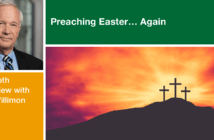Stephanie Remington of the Lewis Center staff reminds us that Christmas traditions can move the spirit and renew the hope of people in our culture, even those who don’t profess faith. She suggests that in developing Advent and Christmas Eve worship, it’s important to hold tight to some familiar traditions.
A friend in his forties, who has largely rejected the church and the Christian faith, surprised me recently by expressing a desire to return to his home church for Christmas Eve. He longed to experience again the tradition of journeying down the sidewalk toward the church in the crisp night by milk jug candlelight, to smell the incense, to see the colors and the lights, to sing the songs, and to hear the words of the Christmas story. Although he does not ascribe to the Christian faith, he still appreciates the church traditions at Christmas — so much so that he was yearning to participate once again in traditions attached to fond family memories, including the memory of the devoted single mother who raised him.
I suspect no day in the year has greater capacity to move our spirit or renew our hope in the story of Christ than this day. What an opportunity to share the good news.
I recently conducted an informal survey on the role of Christmas traditions in our culture and in people’s lives. All those surveyed had fond recollections of celebrating Christmas as a child. For most, their memories involved family or family traditions. For about half of the respondents, attending Christmas Eve services was part of those traditions. Only about 20 percent still celebrated Christmas with the same people as when they were children, because of either death or geographic distance. But the vast majority continue to carry on the traditions of their childhood. For those who did not, there was some expression of sadness and lament. Like my friend, they missed something about the physical, flesh-and-bone enactment of those traditions that connect them to fond memories and people they love and see no more.
Tradition as a Means of Grace
Because Christmas is so deeply engrained in our culture, for Christians and non-Christians alike, it’s the one time of year that a significant proportion of our population appreciates tradition, including the traditions of the church. We want to hear the same scriptures and stories. We want to see the familiar colors and lights and decorations. We want to sing the same familiar hymns. We want to eat the same foods. We want to participate in the same activities — stringing popcorn and cranberries, thumbing through the Sears Wish Book, watching the same old movies, or baking Christmas cookies.
Participation in tradition helps connect us in the present moment to those who still live in our hearts. The traditions can become a means of grace for us, a way to experience God’s grace through others — not only to find comfort in the midst of loss, but to find hope in the refreshed hearing of God’s promise for the world, sometimes even regardless of our beliefs about Christ. Even when exercising our best creativity to develop Advent and Christmas Eve worship that reaches beyond the church walls, it’s important to hold tight to some familiar traditions.
God’s Presence in Fullness and Emptiness
While most of us have fond memories of Christmas, the season also draws us back toward an awareness of those who are no longer with us, evoking an experience of loss. Two-thirds of those responding to my informal survey made reference to loved ones who had died. So, while many will come with smiles and laughter to our Christmas Eve worship services, more than half will go home to empty chairs at their tables.
The traditional colors, smells, songs, and words of promise from Luke (Luke 1:26-35), give us a flesh-and-bone opportunity to hear and participate in the reality that God is present in fullness and in emptiness — that God is with us in the celebrations and the sorrows of life. The draw of tradition can become an introduction to the table that gathers all the saints of heaven and earth. For it is here we learn of anamnesis, of “remembering,” of drawing the past literally into the present at that table. It is here we celebrate even in the midst of sadness, as Christ invites us to the beautiful gift of God’s love in which we are all held, and from which nothing, not even death, can separate us.
I suspect no day in the year has greater capacity to move our spirit or renew our hope in the story of Christ than this day. The spirit and story of Christmas is full of so much more mystery than we can ever imagine, and is the one story most longed for and celebrated regardless of our religious affiliations. What an opportunity to share the good news.
Related Resources
- Room at the Inn by Douglas Ruffle
- Christmas Carols in Advent? Yes! by Janet Craswell
- Reaching More People during Advent by Lovett H. Weems, Jr., and Tom Berlin







